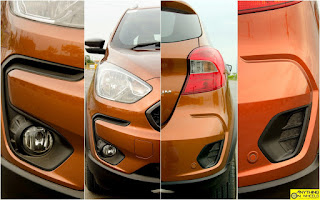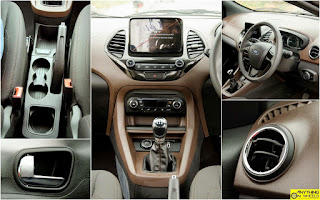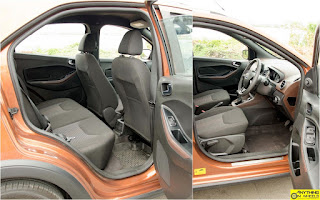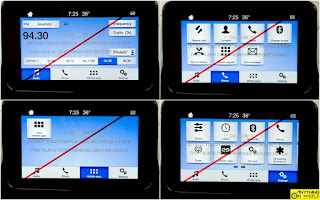Variant Tested: 1.2L Petrol (Titanium +)
Though Ford wants you to believe otherwise, cross hatchbacks aren't exactly new in India. Volkswagen, Toyota, Fiat and Hyundai have all tried their luck in this segment. The American car-maker joined the party recently with the Freestyle, albeit with changes that are more than skin deep. By doing so, Ford has also given it's Figo (and the Aspire that shares the underpinnings) another chance to prove their mettle.
Will Ford's efforts in a segment where success has traditionally been elusive pay off? We spent a few hours in a Freestyle Titanium +, powered by the all-new 1.2-liter Dragon petrol engine, to find out.
Design & Styling
Walk to the Freestyle and it's clear this is a Figo on stilts. Yet, Ford has done enough to give the Freestyle an unique personality that complements it's 'Compact Utility Vehicle' tagline.
Head-on, the now-familiar hexagonal grille gets a gloss black paint job and looks brilliant. That, together with the smoked headlights and redesigned bumpers with prominent C-shaped fog lamp enclosures finished in - you guessed it right - black, gives the Freestyle a classy look. The theme continues in profile with smoked gunmetal alloy wheels complementing the full-length cladding and dark grey decals. At the rear, the taillights get revised detailing while the bumper gets faux vents that matches the shape of the ones found in the front bumper.
Unlike most if it's rivals that have just visual add-ons to bring about that crossover effect, Ford's engineers have actually upped the utility quotient of the Freestyle with thoughtful changes. The ride height is up 16mm over the Figo and measures an useful 190mm, so you don't have to think twice when hitting potholes or speed humps that dot our cities. Roof rails aren't just cosmetic and can hold loads up to 50kg. The track is wider than the Figo's and the Freestyle also gets bigger 15-inch wheels shod with beefier rubber.
In all, the Freestyle looks more attractive and refreshing than the Figo, more so in the Canyon Ridge paint job you see here.
That said, this is a case of missed opportunity as well. At a time when car-buying masses go gung-ho about visual illumination elements like projectors, DRLs and LEDs, the Freestyle is completely devoid of them. Even if these add a few thousands to the cost, Ford should have incorporated them at least in the top-spec Titanium + trim level we drove.
Interiors
When Ford released images of the Freestyle's dual-tone interiors with the brown and black colour combination, "not again" was our first thought, with memories of that awful red-coloured dashboard of the old Figo haunting us. But, we will admit the Freestyle's dash doesn't look half as bad as we thought when seen in person. In fact, it looked quite premium and Ford has nailed it by making this exclusive to the top trim level.
While the basic design and layout of the cabin is the same as the Figo and the Aspire, the addition of a long-overdue touchscreen infotainment system has jazzed up the Freestyle's interiors. The dated Nokia smartphone-inspired center console is out with a slick 6.5-inch screen popping out in it's place. Right below the screen are buttons and knobs for physically controlling the infotainment system while climate control buttons and knobs are located further below. Ford has equipped the Freestyle with an extensive feature list that includes keyless entry with push button start, climate control system, Microsoft's SYNC 3.0 infotainment system (covered separately in our post), rear parking sensors with camera and a full set of active and passive safety features (covered separately in our post).
While the interior quality doesn't hold a candle to the Volkswagens and Hyundais of the segment, it is still decent enough to withstand abuse on Indian roads. Attention to detail, though, has been great. The knurled effect on the climate control knobs, for example, is an impressive touch as is the thick-padded storage tray below that for your smartphone. There are pockets to hold upto eight water bottles in the front row alone and there's also a hidden storage spot that can be accessed only if the driver's door is open for keeping your wallet or other valuable items safe from prying eyes. In such a loaded car, some features like a dead pedal, driver's armrest and adjustable rear head restraints have been given a miss. The bean counters clearly had their say!
The steering wheel is big and meaty and adjustable only for tilt. But the front seats are long, wide and comfortable enough, so finding a good driving position isn't all that difficult. While space at the front is generous, move over to the rear and the space on offer can be, at best, termed adequate. The Baleno and Jazz are miles ahead when rear seat space and practicality are what you are looking for. Apart from fixed head restraints, rear passengers also lack door pads, air vents and central armrest and have to make do with just a single bottle holder. It is clear Ford's focus was on those occupying the front seats.
Boot space, at a good 257 liters, can easily accommodate a family's weekend luggage and a bit more. Moreover, the rear seat can be folded forward to further increase luggage space.
Steering Wheel & Instrument Cluster
Unlike the EcoSport facelift that gets a new steering wheel design, the Freestyle continues with the same design as the previous-generation Ford models like the Fiesta, Figo and Aspire. Despite being a tad bigger than what we would have liked, the steering is good to hold with well thought-out recesses for your thumbs. Piano black detailing on the spokes look great though you will have a tough time keeping dust off it. Controls for BlueTooth telephony, Voice Commands and audio are located on the left spoke while chunky Euro-style stalks behind help control the various vehicle settings.
The instrument cluster is a simple, functional unit dominated by a large circular speedometer in the center flanked by a tachometer and a fuel gauge on either sides. A small Multi Information Display (MID) screen is placed at the bottom of the speedometer. With read-outs for odo, trip, average speed, average fuel consumption, instantaneous fuel consumption and distance-to-empty, the screen gives you what you would require. It's just that the visual flair you come to expect these days is lacking. Given this is what most owners would spend time staring at, Ford should have given the Freestyle - a car aimed at young urban dwellers from Ford's own launch slides - a trendy, upmarket cluster.
Infotainment System
Love them or hate them, floating infotainment screens are here to stay and Ford is one of the many car-makers that has adapted it across the lineup. The old-fashioned button-clad entertainment system has been rightfully shown the door, replaced by a sleek, advanced SYNC 3.0 system.
Armed with seamless connectivity options, slick responses to the touch with zero lag, a crystal clear display and intuitive features that let you explore and master, the SYNC 3.0 has got to be one of the best entertainment systems in the mass market. From the screen that lets us adjust the Balance and Fade settings to it's unique feature set that includes Emergency Assistance (automatically dials 108 in the unfortunate event of an accident), Valet Mode (locks the system before handing over the car to a valet), Ford MyKey (programmable settings for vehicle speed and in-car audio volume), SYNC 3.0 is a masterstroke! Just like the EcoSport, rotary knobs and physical buttons are available for frequently used controls, thereby preventing the need to take your eyes off the road for those quick changes.
In a system this comprehensively equipped, the absence of an in-built navigation system is a bit of a surprise. But then that doesn't matter as the unit is compatible with Apple CarPlay and Android Auto. Ford's AppLink also lets you access and control a handful of applications from our mobile phone as well.
Engine & Transmission
The next big thing in Ford India's powertrain portfolio is the all-new 'Dragon' family of gasoline engines. While the EcoSport facelift debuted the 1.5-liter mill, the Freestyle debuts the smaller 1.2-liter unit that's been developed to comply to the tax concessions being handed out by the Indian Government.
Boasting 95 horsepower and 120 Nm of torque, this new engine is the most powerful sub-1.2-liter unit out there on paper. It's also incredibly refined, especially once it settles down at idle. A gentle dab at the throttle is all that's needed to realize the new Freestyle is peppier than the current Figo and the Aspire. Gone is that lazy and strained build-up of speed, the 1.2-liter Dragon engine is lively right from the word go and retains that characteristic up until it's marked redline of 6,800 rpm. There's a flat zone in the middle and the engine isn't as free-revving as Suzuki's 1.2-liter unit for instance. Moreover, it gets quite vocal at higher revs.
Mated to this engine is an all-new 5-speed manual gearbox sourced from Getrag. The new transmission is a remarkable improvement over the older one with a light clutch complemented by short and crisp shifts. You don't have to put up with the rubbery feel of the gearbox anymore. Automatic transmission is not being offered at the moment, a shame given the increasing acceptance of slush boxes in India.
While we haven't driven that yet, the Freestyle also has a diesel engine powering it, the same tried-and-tested 1.5-liter TDCi unit that churns out 99 horsepower and 215 Nm of torque.
Official fuel-efficiency figures are 19.0 km/l for the 1.2-liter petrol and 24.4 km/l for the 1.5-liter diesel variants. That said, an enthusiastic early morning sprint like ours with ample idling is likely to drag that figure lower, like our 8.0 km/l readout proves.
Ride & Handling
The original Figo launched in 2010 was a benchmark in the small car segment, thanks to it's exemplary ride and handling balance. The second-generation Figo strayed off this line before Ford did some course correction with the S variant launched a couple of years back. We are happy to report the Freestyle is more Figo S than the regular Figo when it comes to exhibiting trademark Ford DNA.
Ride quality is supple and the car absorbs bumps and potholes with remarkable poise. Go faster and the Freestyle isn't unsettled as a softly-sprung car would be. With a far stiffer ride, Ford's own EcoSport has to learn a thing or two from the Freestyle's suspension tuning. The MacPherson struts up front and the twist beam at the rear do their jobs exceedingly well and leave no room to complain. Handling is spot-on as well despite the Freestyle being a high-riding cross hatch. Body roll is non-existent at slow and medium speeds and well-controlled at high speeds. This, coupled with a responsive steering and superb straight-line stability at high speeds, make the Freestyle one fun-to-drive car.
The 185/60 R15 tires offer sufficient grip for everyday driving with the ventilated discs up front and drums at the rear endowing the car with good braking abilities.
Safety
Ford, along with Toyota and Volkswagen, is at the forefront when it comes to exhibiting utmost commitment to safety. Have no doubt, all you need is a glance through the Freestyle's brochure to put those concerns to rest.
Freestyle's standard safety kit across the lineup includes dual front airbags, Anti-lock Braking System (ABS) with Electronic Brake-force Distribution (EBD), seat belt reminders for the driver and front passenger, reverse parking sensor and speed-sensing automatic door locks. The top-spec Titanium + variant, the one we drove, is even more generously equipped with features like side and curtain airbags, Active Rollover Prevention (collective term for Hill Launch Assist, Electronic Stability Program and Traction Control System), Emergency Assistance, Ford MyKey and rear view camera.
With such armory, it is clear the Freestyle is amongst the safest car in the country this side of 10 Lakh Rupees. Well done, Ford, for leading the way!
Verdict
From the very beginning, it was pretty clear the Freestyle is unlike any other cross hatchback we have seen. This car is not just a hatchback with a few cosmetic embellishments and plastic panels added on. Now, after spending quality time with it, the Freestyle has moved itself out of the Figo's shadow and emerged as a genuine contender for the segment honours. Sure, there are a few essentials missing from the package and the car isn't as spacious as some of its competitors are, but by virtue of offering so much more in other aspects for significantly lesser money than its rivals, the Freestyle might just be the success that has eluded Ford recently in the mass market.
Photography: Bharath Rengaraj
Content & Editing: Aravind Ramesh























